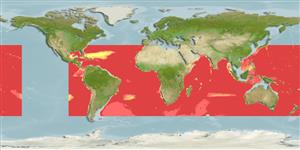>
Stomiiformes (Lightfishes and dragonfishes) >
Stomiidae (Barbeled dragonfishes) > Melanostomiinae
Etymology: Melanostomias: Greek, melan, -anos = black + Greek, stoma = mouth (Ref. 45335).
Environment: milieu / climate zone / depth range / distribution range
Ecologia
marino batipelagico; distribuzione batimetrica 350 - 1024 m (Ref. 58302). Deep-water; 36°N - 49°S, 98°W - 154°W
Atlantic Ocean: northern Atlantic between 35°N-8°N (not occurring in the southern Sargasso Sea), Gulf of Mexico and the Caribbean Sea; southwestern Atlantic between 10°S and 30°S. Also known from the Indian and Pacific oceans.
Size / Peso / Age
Maturity: Lm ? range ? - ? cm
Max length : 26.0 cm SL maschio/sesso non determinato; (Ref. 37039)
Short description
Chiavi di identificazione | Morfologia | Morfometria
Raggi dorsali molli (totale) : 13; Raggi anali molli: 15. Body elongate and moderately slender. Short, blunt, non protrusible snout. Barbel has slender stem, flattened narrow distal tip. Black in color. Stem of barbel unpigmented except for the base, tip of barbel unpigmented or has irregular dark patches (Ref. 37039).
Mesopelagic (Ref. 58302).
Life cycle and mating behavior
Maturities | Riproduzione | Spawnings | Egg(s) | Fecundities | Larve
Gibbs, R.H. and M.A. Barnett, 1990. Melanostomiidae. p. 308-337. In J.C. Quero, J.C. Hureau, C. Karrer, A. Post and L. Saldanha (eds.) Check-list of the fishes of the eastern tropical Atlantic (CLOFETA). JNICT, Lisbon; SEI, Paris; and UNESCO, Paris. Vol. 1. (Ref. 4468)
IUCN Red List Status (Ref. 130435)
Threat to humans
Harmless
Human uses
Strumenti
Special reports
Download XML
Fonti Internet
Estimates based on models
Preferred temperature (Ref.
123201): 6.8 - 11.9, mean 8.7 °C (based on 525 cells).
Phylogenetic diversity index (Ref.
82804): PD
50 = 0.5000 [Uniqueness, from 0.5 = low to 2.0 = high].
Bayesian length-weight: a=0.00302 (0.00117 - 0.00783), b=3.12 (2.89 - 3.35), in cm total length, based on LWR estimates for this (Sub)family-body shape (Ref.
93245).
Trophic level (Ref.
69278): 4.2 ±0.73 se; based on food items.
Resilienza (Ref.
120179): Medio, tempo minimo di raddoppiamento della popolazione 1.4 - 4.4 anni (Preliminary K or Fecundity.).
Fishing Vulnerability (Ref.
59153): Low vulnerability (22 of 100).
